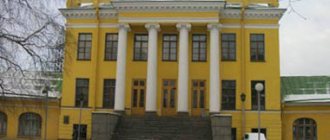Description and location
You can get to the registry office of the Vyborg district from the Ploshchad Muzhestva metro station, which is located not far from the government agency, or you can walk from 2nd Murinsky Avenue through the gate. The building of the Vyborg registry office is completely surrounded by a small park, in which the newlyweds can then do a small wedding photo shoot.
The territory of the registry office of the Vyborg district is equipped with its own parking area. This area is large enough and therefore you can easily leave a wedding limousine there. If, however, all the parking spaces in front of the building are occupied, then you can park your vehicle behind the building of the Vyborg Civil Registry Office.
Wedding
Walking down the aisle is a celebration of a newly created family, a starting point for a new family life. Each couple sees their own wedding differently. It must be unique. All newlyweds believe that they are the ones who will be able to organize and hold a wedding evening at the highest level. Many couples prefer to hold their wedding themselves or take an active part in every stage of its organization. Others decide to trust the agency in this matter. And there is absolutely no need to worry that professionals will not be able to work out all the details in organizing a wedding. Specialists of event agencies accept all the most daring and creative wishes, conduct a wedding celebration in accordance with your order. At the same time, you are free from the routine of the organization, but at any time you can make adjustments or correct specialists.
Design and photo
If we describe the interior of the Vyborg Civil Registry Office in a few words, then this building is decorated “in the spirit of modernity.” The registry office of the Vyborg district is divided into two zones - guest and ceremonial. These two areas are quite spacious and can accommodate the largest wedding processions within their walls.
The guest area is a bright and very spacious room, which is furnished with soft sofas. In the guest hall, invited relatives and friends can comfortably await the start of the wedding.
The newlyweds and guests of the celebration leave the ceremony hall of the Vyborg registry office through the winter garden, in which you can see spreading palm trees and many other tropical plants. Against the backdrop of this greenery, you can take a number of photographs for a family album. Thanks to the winter garden, the building of the Vyborg Civil Registry Office becomes more “alive” and solemn and has a certain charm.
The "Bridge of Love" is a long and elegant passage that starts from the bride and groom's apartments and leads directly to the ceremony hall for the registration of the marriage. The entire bridge structure is beautifully decorated with flowers and harmoniously equipped with its own lighting. On the “Bridge of Love” newlyweds can take a lot of beautiful photos.
The apartments of the future spouses are quite modest. All that is provided for the convenience of young people is a few tables and chairs, as well as typical upholstered furniture. The ceremony hall is also furnished in a minimalist style - a few chairs for guests, carpeted floors, modern chandeliers, a grand piano and walls painted in pink and beige tones.
The table of the master of ceremonies, at which he conducts the wedding process, has remained here since the Stalin era. This is a fairly high platform, which takes up two-thirds of a person’s height. Newlyweds with short stature may find it quite inconvenient to sign the registration book. The exchange of rings takes place in the heart of the ceremony hall.
Vyborg Civil Registry Office
Location and parking features
The Vyborg Civil Registry Office is located near the Ploshchad Muzhestva metro station.
Another way to get there is to walk from 2nd Murinsky Avenue through the gate. One of the significant advantages of the Vyborg Civil Registry Office is a small park that surrounds the building and can serve as a place for small photo sessions.
Its second advantage is its own parking, and it is very spacious. A large wedding procession can be freely placed not only on it, but also behind the building of the Vyborg Registry Office in St. Petersburg - there is also a lot of space there.
Civil registry office layout
“In the spirit of modernity” - this, in short, is how we can characterize the interior of the Vyborg Civil Registry Office in St. Petersburg: it is all divided into two zones - guest and ceremonial. They are both very spacious and can accommodate the most crowded weddings.
The guest area is represented by a bright and spacious hall with soft sofas - on which relatives and friends of the newlyweds invited to the celebration can wait for the ceremony to begin.
Next, behind the columns, is the winter garden. The path of newlyweds and guests leaving the Vyborg registry office after registration lies through it. There is quite a lot of greenery here - spreading palm trees and other tropical vegetation really enliven and add charm to the overall very ordinary building.
But above the columns is that very highlight, the Bridge of Love, a long and spectacular passage along which couples go from the bride and groom’s rooms to the Ceremonial Registration Hall for painting. It has its own lighting and is beautifully decorated with flowers.
The rooms of the bride and groom are modestly furnished: the newlyweds have only standard upholstered furniture and a few tables and chairs.
The Celebration Hall itself is also decorated and furnished without frills. Several quite nice chairs for guests, a long carpet on the floor, brightly burning modern chandeliers, a grand piano and a beige-pink wall design - that’s all the characteristics of its interior.
Wedding guests are invited to registration first; the newlyweds are the last to enter.
The master of ceremonies leads the celebration behind a special podium that has remained in the Vyborg registry office since Soviet times. Its main drawback is not its massiveness: the problem is created by its height, which reaches almost two-thirds of human height, so it can be very difficult for short brides and grooms to sign signatures in the accounting register.
The young couple exchange rings in the middle of the hall.
Recommendations
1. The bride, groom and guests must arrive for registration 40 minutes before the upcoming ceremony. During this time, you can prepare for it and take a few shots inside the registry office and in the park surrounding the building
2. It is also recommended to invite your photographer
3. Since the entry of motorcades into the territory of the Vyborg Civil Registry Office is carried out from the very narrow Parkhomenko Avenue, drivers are asked not to park near the fence of the institution so as not to block traffic
4. The administration and employees of the Vyborg Civil Registry Office ask not to litter in its premises and on the territory: scattering candies, flowers, grains, as well as using fireworks and firecrackers is prohibited here
Note to those getting married
- It is better to arrive at the wedding ceremony in advance - about 40 minutes. This time is quite enough to prepare for the future celebration and take the first few photos for the family album.
- The Vyborg Civil Registry Office does not have its own photographer, so it is worth hiring him elsewhere.
- Since wedding limousines enter the territory of the Vyborg Civil Registry Office from Parkhomensky Prospekt, drivers should not park the vehicle near the fence of the government agency, as this may block traffic.
- On the territory of the Vyborg Civil Registry Office it is prohibited to litter, appear drunk and use wedding paraphernalia (coins, flower petals, grain and pyrotechnics).
Wedding ceremony
In order to become legal spouses, you must go through the registration procedure.
One of the most important aspects of this process is submitting applications. This requires increased attention when filling out questionnaires and additional contracts. To avoid misunderstandings during an important procedure, it is necessary to agree in advance on a change of surname and other formalities. Then no obstacles can stand in the way of your cherished goal.
You should also decide on the type of event. The ceremony can take place in the official setting of the registry office, or freely or outside.
The registration itself can be ordered with a solemn ceremony and compliance with all the rules. Or it can be done in a calm atmosphere in the registry office room.
How to work with the registry office collection – Archives of St. Petersburg
Acts of civil status of Petrograd (Leningrad) and Petrograd (Leningrad) province for 1918 - 1924 were transferred for state storage to the Central State Archive of St. Petersburg in 1997 - 2001. The acts for subsequent years remained in departmental storage; they will remain there, according to the law, at least until 2025 (one hundred years from the date of creation). However, the chronology in a number of books (mainly with birth certificates) is conditional. This will be discussed in detail in one of the next issues of the “Archives of St. Petersburg” group. Now look at the cover of the case, which contains the birth certificates of the Volodarsky registry office for 1923. Please note the disclaimer: birth records are available for earlier and later years (up to 1926). Unfortunately, in a number of cases there are gross typos in the electronic search system. Inventory 3 is especially guilty of them, where in the file, for example, 213, there are acts of 2028 (!!). What can you do, the human factor.
The archive received over 7.7 thousand civil registration books according to four inventories. Inventory 5 concerns changes to vital records and its files are not yet available for viewing. The received materials formed an archival collection under No. R-6143. Why a collection and not a foundation? Yes, because only acts were received for storage, and other documents from district registry offices (though not all) for 1918 - early 1920s formed independent funds. A complete list of them is given in the archive guide on page 276 of the second volume. There is also a collection of the City Civil Registry Office in the archives (f. R-4904), where the list of men who changed their surnames upon marriage for the years 1918 - 1940 is of some interest. The list was compiled by employees of the registry office for reference purposes and has no legal force.
But let's return to fund 6143. Searching for it is difficult and requires some preparation. Strictly speaking, a normal search is only possible if you know the exact place of registration of a particular act of civil status. In some ways, this is similar to searching for registry books for temples.
Systematization of acts for 1918 – 1924. carried out according to the administrative division of St. Petersburg and the Leningrad region at the end of the twentieth century. Thus, in Inventory No. 1, urban materials are systematized into 14 urban districts, the absolute majority of which did not exist during the years when the acts were created. For example, the Kalininsky district was separated from the Vyborgsky district in 1936; Kolpino, Kronstadt, Petrodvorets, Pushkin became part of Leningrad in the late 1930s; The Nevsky district was called Volodarsky until 1948. However, it is precisely in these areas that the cases for 1918–1924 are systematized. The first acquaintance with such an inventory causes a certain shock. What caused such an ahistorical approach by the compilers? It's simple. When organizing a new administrative district, the books of acts of all territories that were included in it were transferred to it (to the district registry office). The same thing happened when the boundaries of the region expanded. For example, in 1950, the village of Rybatskoye, Pavlovsk district, Leningrad region, was transferred to the administrative subordination of the Nevsky district council of Leningrad, and accordingly, the registry office books of the Rybatskaya volost ended up in the Nevsky district registry office. Due to frequent changes in the administrative division of the city, it is quite difficult to trace the “journey” of the registry office books. Unfortunately, the inventory also contains significant errors in systematization caused by ignorance of the realities of those days. Thus, the Petrogradsky district includes the marriage registration book of the St. Petersburg City Council, which, as is known, was located on Nevsky Prospekt. The civil department, mentioned in the same place, is the department that managed the registry office, it is possible that due to the complex structure of the Petrograd region, which included suburban areas, it was also involved in the registration of acts. In several funds of the civil departments of the district councils of Petrograd for 1918 - 1923. There are applications from citizens for the issuance of birth certificates, changes of surnames, and divorces (see pp. 266 – 267 of the second volume of the Archive Guide).
Knowing the place of registration, it is necessary to determine the name of the district where the registration took place, and preferably the current administrative subordination. For 1922 – 1923 The area can be determined from the directories “All Petrograd” (section “Streets”), electronic copies of which are posted by the Russian National Library (RNB) on the Internet. For earlier years, we recommend that you refer to the reference book “Petrograd” of 1917 (section “Streets”). Maps of the administrative-territorial division of the city, available in the St. Petersburg encyclopedias, as well as on the Internet, can be of great help. After the “old” and “new” areas have been established, you can turn to the inventory to find the necessary books.
Please note that in many areas there are alphabets for acts for certain years, which can be viewed to determine the exact date and act number, and then refer directly to them.
We recommend viewing both copies of the civil status act, as there may be discrepancies.
Well, what to do if the location of the event is unknown? Come to the reading room of the archive, where you have access to a search database for all the surnames found in the registry office books. Unfortunately, for technical reasons it is not yet possible to put it online.
Contacts
Address
City: Moscow
District: North-Western Administrative District
District: Khoroshevo-Mnevniki district
Website: www.mos.ru/zags/function/organizagsupravleniya/khoroshevskii-otdel-zags/
Metro: Oktyabrskoye Pole
Street: People's Militia Street, building 23, building 2
Payment: ₽
Our coordinates
Latitude: 55.77864887986
Longitude: 37.476218883449
Telephone:
Email:
Content







